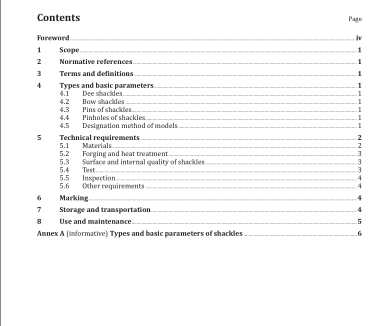ISO 16857:2013 pdf download.Ships and marine technology — Loose gear of lifting appliances on ships — Shackles
This International Standard specifies the types and basic parameters, technical requirements, marking,storage, and transportation, use and maintenance of shackles, loose gear of lifting appliances on ships.
This International Standard is applicable to lifting appliances on ships.
2 Normative references
The following documents, in whole or in part, are normatively referenced in this document and are indispensable for its application. For dated references, only the edition cited applies. For undated references, the latest edition of the referenced document (including any amendments) applies.
ISO 261, ISO general purpose metric screw threads — General plan
ISO 2415, Forged shackles for general lifting purposes — Dee shackles and bow shackles
ISO 16855, Ships and marine technology — Loose gear of lifting appliances on ships — General requirements 3? Terms? and? definitions
For the purposes of this document, the terms and definitions given in ISO 2415 and ISO 16855 apply.
4 Types and basic parameters
4.1 Dee shackles
For the shapes and dimensions of Dee shackles, see A.1.
4.2 Bow shackles
For the shapes and dimensions of Bow shackles, see A.2.
4.3 Pins of shackles
For the types of pins of shackles (Type W, Type X, and Type Y), see A.3.
4.4 Pinholes of shackles
For the diameters of pinholes of shackles, see A.4.
4.5 Designation method of models
The model of shackles shall be designated as follows:
EXAMPLE 1 Dee shackles with Type W pins and 20 t SWL:
Shackle ISO 16857 S-DW20
EXAMPLE 2 Bow shackles with Type X pins and 10 t SWL:
Shackle ISO 16857 S-BX20
5 Technical requirements
5.1 Materials
5.1.1 Shackle materials shall use solid steel manufactured by Martin furnaces, electric furnaces, or oxygen top blown converters; it is recommended to use the electroslag remelting process.
5.1.2 For the chemical composition of shackle materials, see Table 1. Other materials can be used (see 5.6).
5.1.4 When the design temperature of lifting appliances on ships is below −10°C, the impact energy test temperature of shackle materials shall satisfy the requirements of related certification organizations, such as classification societies.
5.2 Forging and heat treatment
5.2.1 Shackle bodies need to be forged with seamless solid blanks, and two pinholes shall be coaxial and concentric with two outsides of eyes; pins shall be cut from bars, and machined after forging.
5.2.2 Heat treatment shall be made after shackle forging to achieve the properties specified in 5.1, with no more than three times of heat treatment.
5.3 Surface and internal quality of shackles
5.3.1 The surface of shackles shall be smooth and clean, without any defect such as burrs, cracks, folding, and burning.
5.3.2 Defects in shackles cannot be rewelded.
5.3.3 Shoulders or heads of pins (Type W and Type Y) after assembly shall fit into the bodies. When thread pins are screwed up, visible residual threads between dimensions of shackles (W) shall not be more than 1 pitch. After the correct assembly of pins, in no case shall the inner width (W) of the bodies be obviously reduced. 5.3.4 Threads shall meet the requirements of ISO 261, and the fit accuracy of threads is 6g/6H.
5.4 Test
5.4.1 Each shackle shall be proof-tested, with test loads given in Table 3. Proof load shall be applied to each shackle with a testing machine or test weight for a duration of not less than 5 min.
5.4.2 After proof testing, each shackle shall be thoroughly examined for deformation, cracks, or other defects and to ensure that its rotating parts can rotate freely. Increment of the body length (S) or length increment measured from the mark between the crown and pin shall not exceed 0,25 % thereof or 0,5mm, whichever is greater. 5.4.3 When shackles of various specifications are manufactured for the first time or upon the request of related organizations, such as classification societies, static strength tests shall be carried out for shackles, the ultimate strength load during the test is four times the safe working load. After 5 min of the static strength test, shackles shall not break or deform to the extent that they lose the bearing capacity.ISO 16857 pdf download.ISO 16857-2013 pdf download
